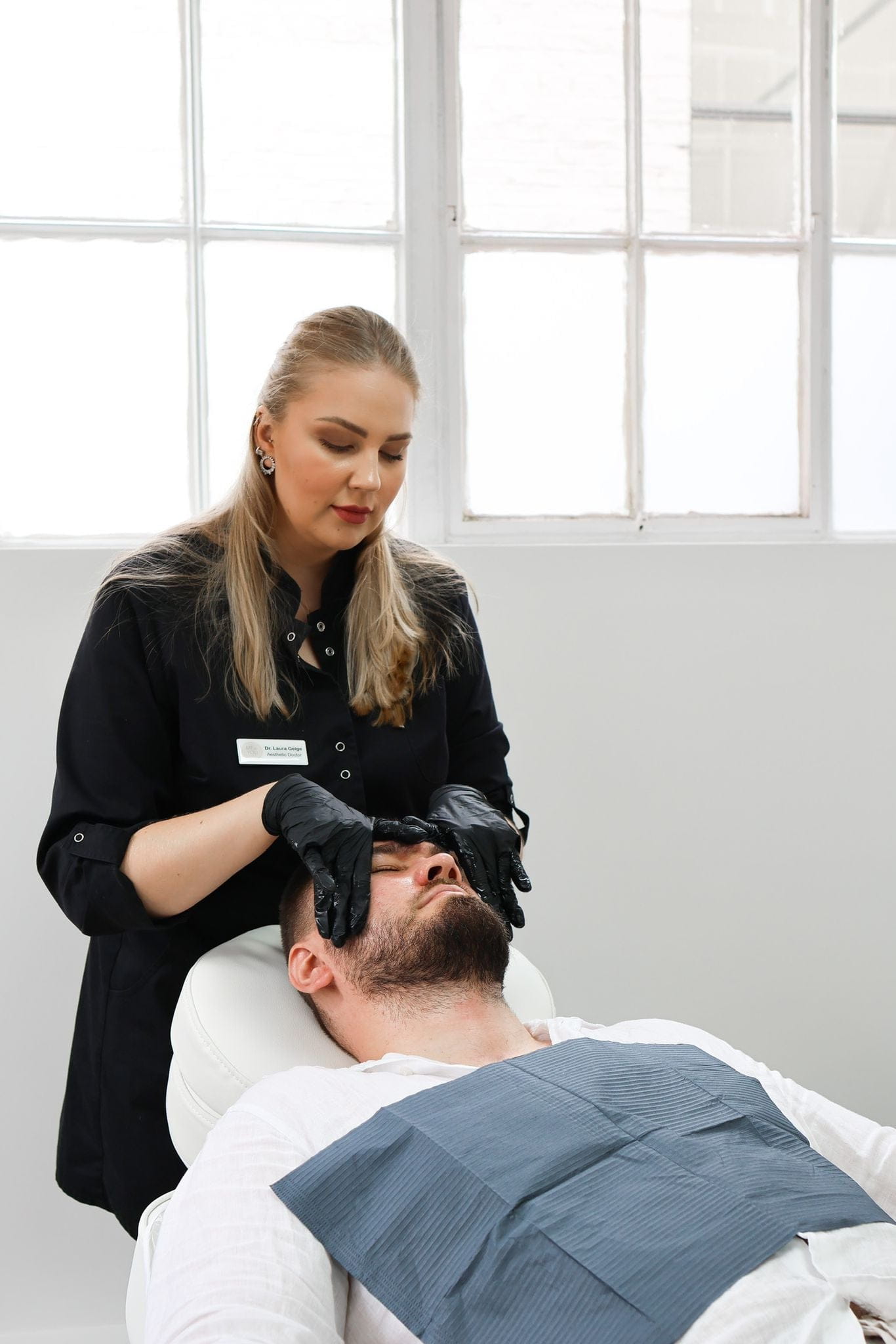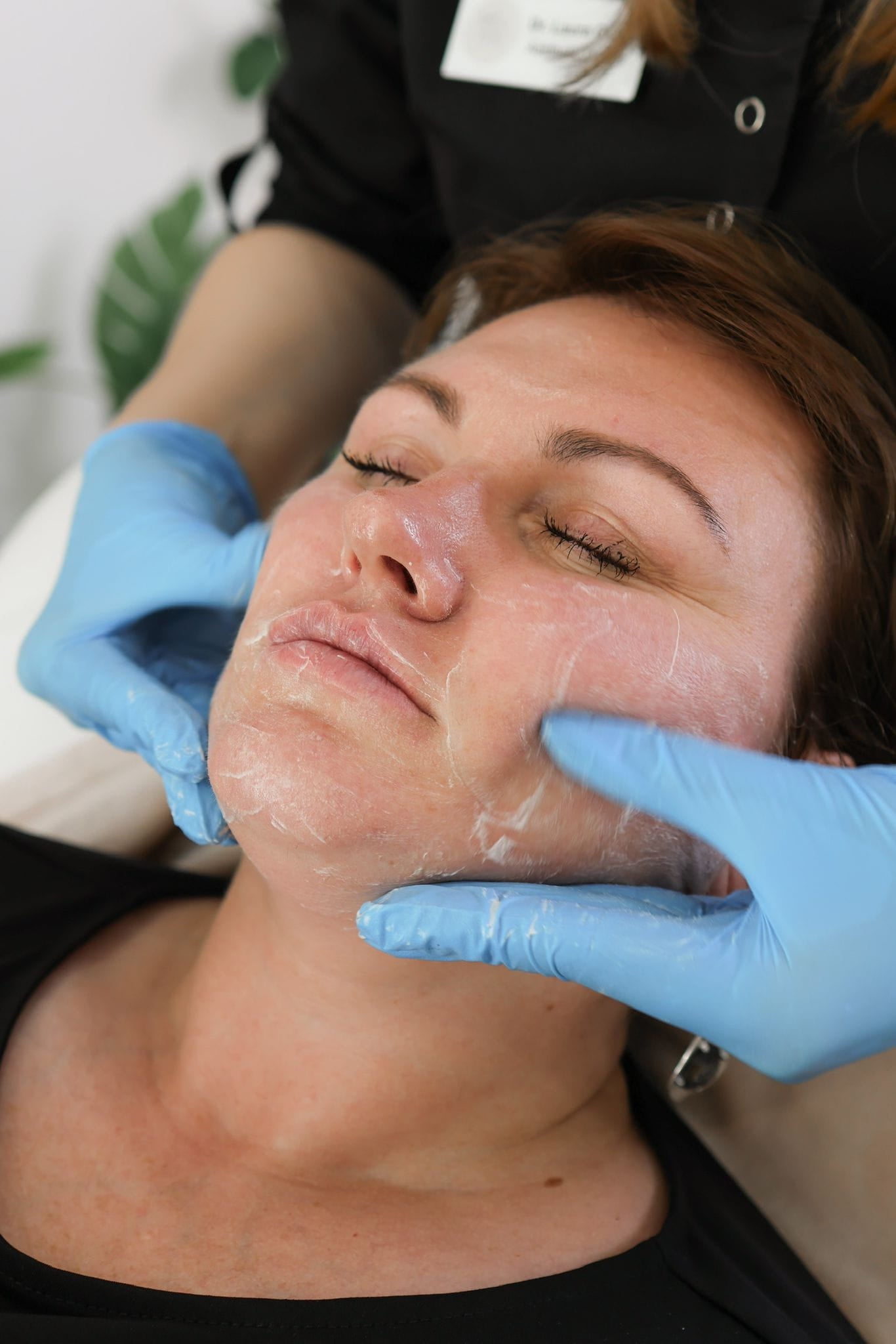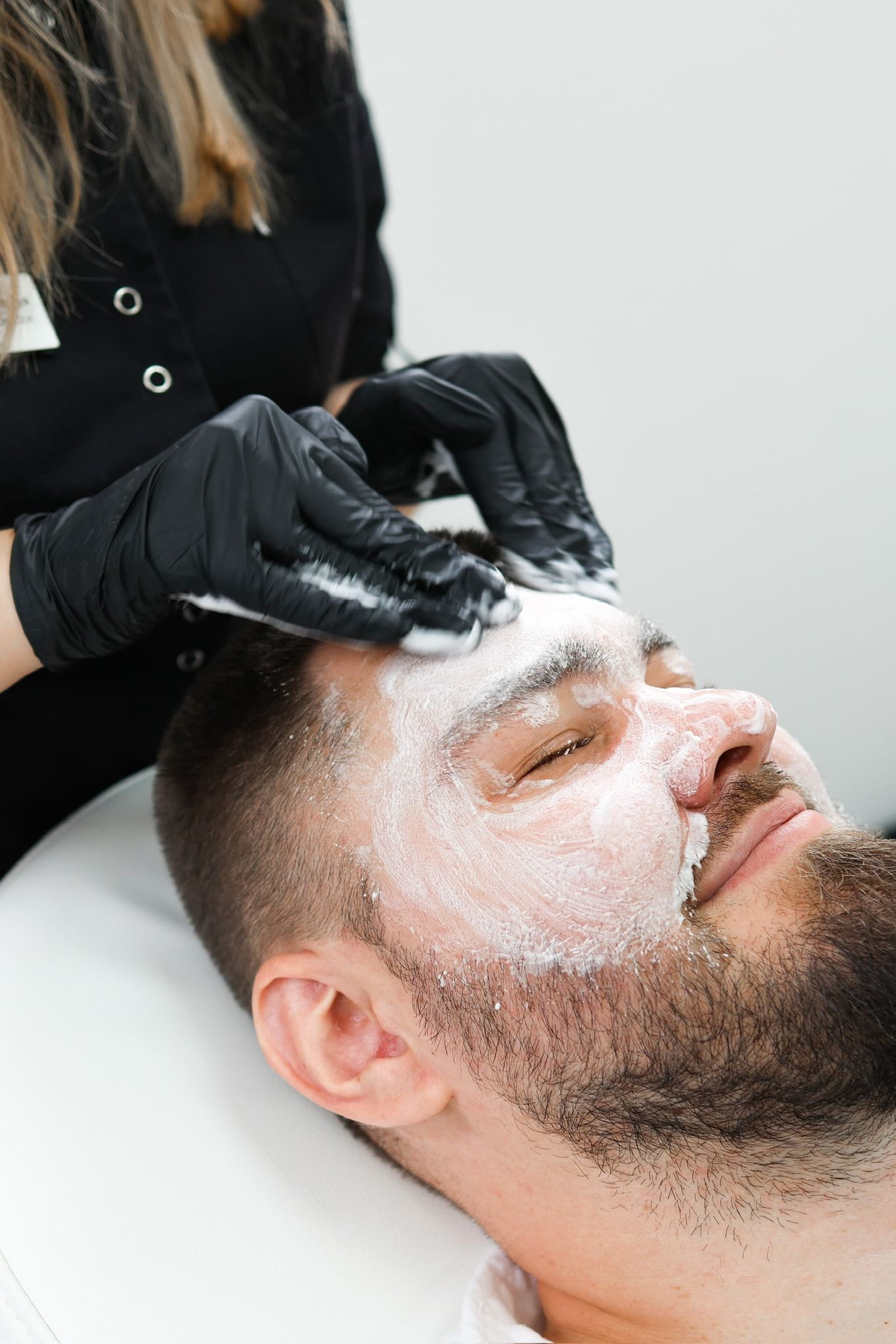Cosmelan Depigmentation Peel
Cosmelan Depigmentation Peel is a popular treatment for hyperpigmentation, including melasma and sun spots. This intensive chemical peel utilizes a combination of powerful ingredients designed to target melanin production and lighten existing pigmentation.
Mechanism of Action
Cosmelan Depigmentation Peel works by inhibiting tyrosinase, the enzyme responsible for melanin production. The peel contains high concentrations of ingredients like hydroquinone, kojic acid, and azelaic acid which act synergistically to reduce melanin synthesis within melanocytes. Additionally, it exfoliates the outer layer of skin, removing pigmented cells and promoting cell renewal, leading to a gradual reduction in hyperpigmentation.

Pigmentation Concerns in Menopause
Menopause can trigger hormonal fluctuations that often lead to increased pigmentation concerns. Many women experience melasma, sun spots, or age spots during this life stage. Cosmelan Depigmentation Peel is increasingly being sought out as a potential solution for these pigmentation issues in the UK.
While Cosmelan has proven effective for many individuals with hyperpigmentation, its efficacy for menopause-related pigmentation requires careful consideration. The hormonal changes associated with menopause can influence melanin production and make it more challenging to achieve long-lasting results. It’s crucial to consult with a dermatologist or qualified skincare professional to determine if Cosmelan is suitable for addressing your specific concerns.
Effectiveness for Menopausal Pigmentation
Cosmelan Depigmentation Peel, with its potent blend of depigmenting agents like hydroquinone, kojic acid, and azelaic acid, aims to reduce melanin production within melanocytes. This can be beneficial for tackling pigmentation issues associated with menopause, such as melasma and sun spots, which are often triggered by hormonal fluctuations.
However, the success of Cosmelan for menopausal pigmentation is not guaranteed. Hormonal shifts during menopause can continue to influence melanin production, potentially hindering long-term results. It’s essential for women considering this treatment to consult a dermatologist who can assess individual skin conditions and hormonal profiles to determine if Cosmelan is an appropriate option.
Clinical Studies and Evidence
Cosmelan Depigmentation Peel has gained recognition as a potential solution for hyperpigmentation concerns, including those associated with menopause. Clinical studies have demonstrated its effectiveness in reducing melasma, sunspots, and other forms of pigmentation.
Studies have shown that Cosmelan’s combination of ingredients, such as hydroquinone, kojic acid, and azelaic acid, effectively inhibits melanin production and exfoliates the skin, leading to a noticeable reduction in pigmentation. While these findings provide a foundation for its potential use in addressing menopause-related pigmentation, it’s important to recognize that individual responses can vary.
The influence of hormonal fluctuations during menopause can make achieving long-lasting results challenging. It’s crucial to consult with a dermatologist or qualified skincare professional who can assess your specific skin type, hormonal profile, and medical history to determine if Cosmelan is an appropriate treatment option.
Real-Life Patient Experiences
Cosmelan Depigmentation Peel utilizes powerful ingredients like hydroquinone, kojic acid, and azelaic acid to target melanin production and lighten existing pigmentation.
- Hydroquinone inhibits tyrosinase, the enzyme responsible for melanin synthesis.
- Kojic acid also interferes with melanin production by inhibiting tyrosinase activity.
- Azelaic acid works to reduce inflammation and inhibit melanin formation.
While promising, its effectiveness in treating menopause-related pigmentation can vary.
- Hormonal fluctuations during menopause can make achieving long-lasting results more challenging.
- Some women may experience recurrence of pigmentation despite treatment.
- It’s crucial to consult with a dermatologist or qualified skincare professional who can assess your individual needs and advise on the most suitable treatment approach.
Potential Side Effects and Risks
Like any medical procedure, Cosmelan Depigmentation Peel carries potential side effects and risks. These can include temporary redness, irritation, dryness, peeling, and sensitivity to sunlight. In some cases, more serious side effects such as allergic reactions or skin discoloration may occur. It is essential to discuss your medical history and any existing skin conditions with a qualified professional before undergoing this treatment.
Common Side Effects
Cosmelan Depigmentation Peel has potential side effects and risks associated with it.
Some common side effects include temporary redness, irritation, dryness, peeling, and increased sensitivity to sunlight. It’s crucial to protect your skin from sun exposure during the healing process and for a period afterward.
More serious side effects, though less common, may occur, such as allergic reactions or changes in skin pigmentation.

It is important to consult with a dermatologist before undergoing this treatment to discuss potential risks and benefits based on your individual medical history and skin condition.
Serious Complications
Like any medical procedure, Cosmelan Depigmentation Peel carries potential side effects and risks. These can include temporary redness, irritation, dryness, peeling, and sensitivity to sunlight. In some cases, more serious side effects such as allergic reactions or skin discoloration may occur. It is essential to discuss your medical history and any existing skin conditions with a qualified professional before undergoing this treatment.
Potential side effects can vary from person to person and depend on factors such as skin type, the severity of pigmentation, and individual sensitivity. It’s crucial to follow all post-treatment instructions provided by your dermatologist to minimize the risk of complications and promote optimal healing.
Cost and Accessibility in the UK
The cost and accessibility of treatments like Cosmelan Depigmentation Peel can vary significantly within the UK. Factors such as geographic location, the experience of the practitioner, and the specific clinic or spa offering the treatment all contribute to price differences.
Treatment Cost
The cost of a Cosmelan Depigmentation Peel in the UK can range from £300 to £600 or more per session. Multiple sessions are often required to achieve desired results, so the overall cost can be substantial.
Accessibility depends on factors like location and clinic availability. Larger cities tend to have more clinics offering this treatment, but access might be limited in rural areas.
Availability of Practitioners
The cost and accessibility of treatments like Cosmelan Depigmentation Peel can vary significantly within the UK. Factors such as geographic location, the experience of the practitioner, and the specific clinic or spa offering the treatment all contribute to price differences.
The cost of a Cosmelan Depigmentation Peel in the UK can range from £300 to £600 or more per session. Multiple sessions are often required to achieve desired results, so the overall cost can be substantial. Accessibility depends on factors like location and clinic availability. Larger cities tend to have more clinics offering this treatment, but access might be limited in rural areas.
Alternatives to Cosmelan Peel for Menopausal Pigmentation
While Cosmelan Depigmentation Peel has gained popularity for addressing hyperpigmentation, it’s essential to explore alternative treatments for menopausal pigmentation concerns. Options such as chemical peels with milder formulations, topical creams containing ingredients like vitamin C, retinol, or licorice root extract, and laser treatments can offer effective solutions for reducing pigmentation caused by hormonal fluctuations.
Other Depigmentation Treatments
Alternatives to Cosmelan Depigmentation Peel exist for managing menopausal pigmentation. Chemical peels with less potent formulations than Cosmelan can be a gentler option, targeting hyperpigmentation without the same intensity.
Topical creams containing ingredients like vitamin C, retinol, or licorice root extract can also be beneficial. Vitamin C is a potent antioxidant that inhibits melanin production, while retinol promotes cell turnover and fades existing pigmentation.
Licorice root extract has depigmenting properties and can help even out skin tone. Laser treatments, such as fractional laser therapy or intense pulsed light (IPL), target pigmented cells with focused light energy, leading to gradual reduction in hyperpigmentation.
Lifestyle Modifications and Skincare Products
Lifestyle modifications can play a significant role in managing menopausal pigmentation. Protecting your skin from the sun’s harmful UV rays is paramount. Always wear broad-spectrum sunscreen with an SPF of 30 or higher, even on cloudy days.
Avoid prolonged sun exposure during peak hours (10 am to 4 pm) when the sun’s rays are strongest. Wearing protective clothing such as hats and sunglasses can provide additional shielding for your skin.
Maintaining a balanced diet rich in antioxidants can help protect against damage caused by free radicals, which contribute to pigmentation. Incorporating fruits, vegetables, and healthy fats into your meals supports overall skin health.
Getting enough sleep allows your body to repair and regenerate, promoting healthy cell turnover and reducing the appearance of pigmentation. Managing stress through techniques like yoga, meditation, or exercise can also benefit skin health.

Several skincare products can be incorporated into a routine to address menopausal pigmentation. Products containing vitamin C are effective in inhibiting melanin production and brightening the complexion. Look for serums or creams with stable forms of vitamin C, such as L-ascorbic acid or magnesium ascorbyl phosphate.
Retinol, a derivative of vitamin A, promotes cell turnover and helps fade existing pigmentation. Start with a low concentration and gradually increase as tolerated to avoid irritation.
Licorice root extract is known for its depigmenting properties and can help even out skin tone. It can be found in serums, creams, or masks.
- How Long Does It Take To See Results From Marionette Lines Fillers In Surrey - August 20, 2025
- How Kratom Capsules May Help You Overcome Fatigue And Exhaustion - August 10, 2025
- How Effective Is The Cosmelan Depigmentation Peel For Melasma In The UK - August 7, 2025
